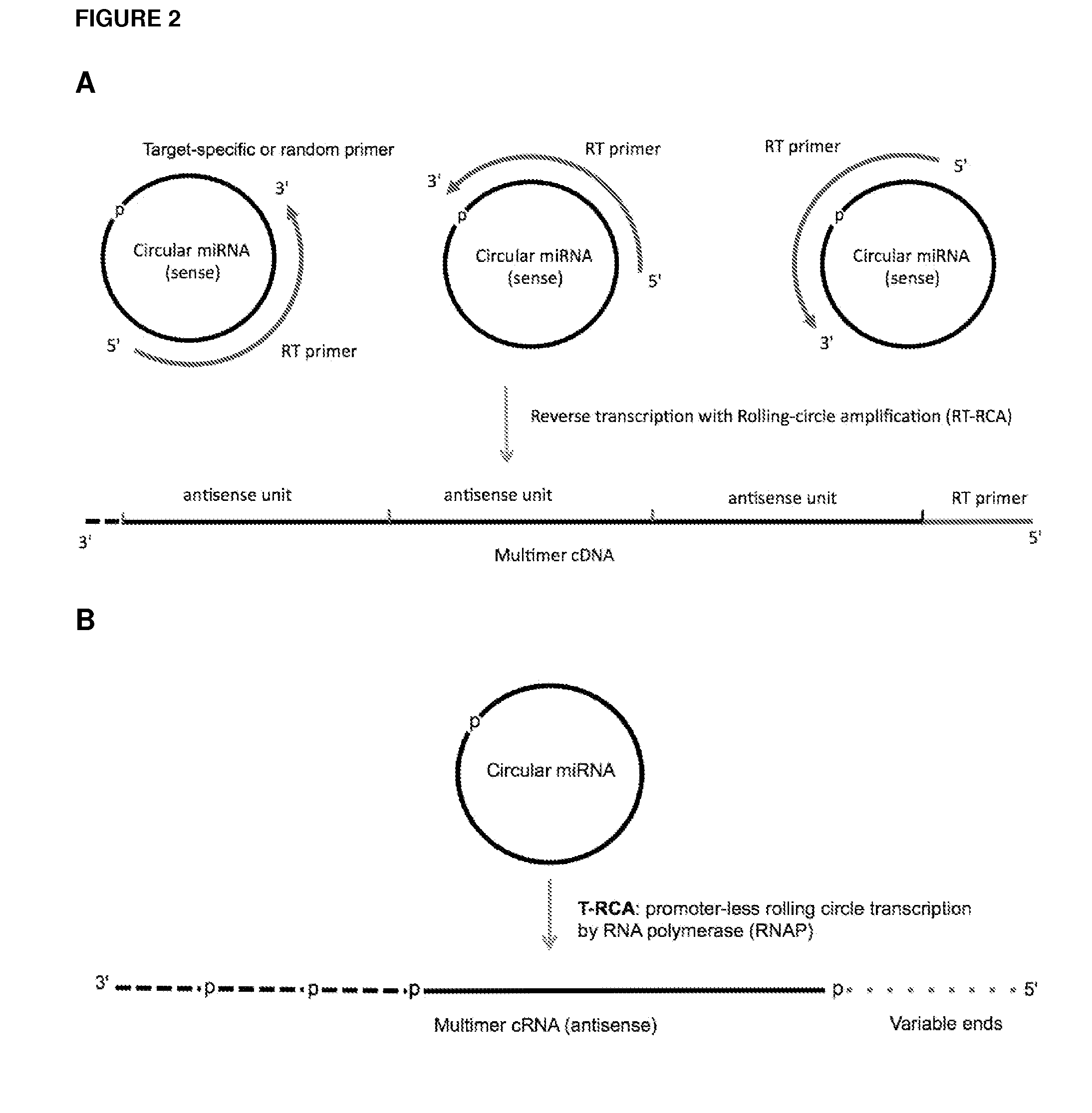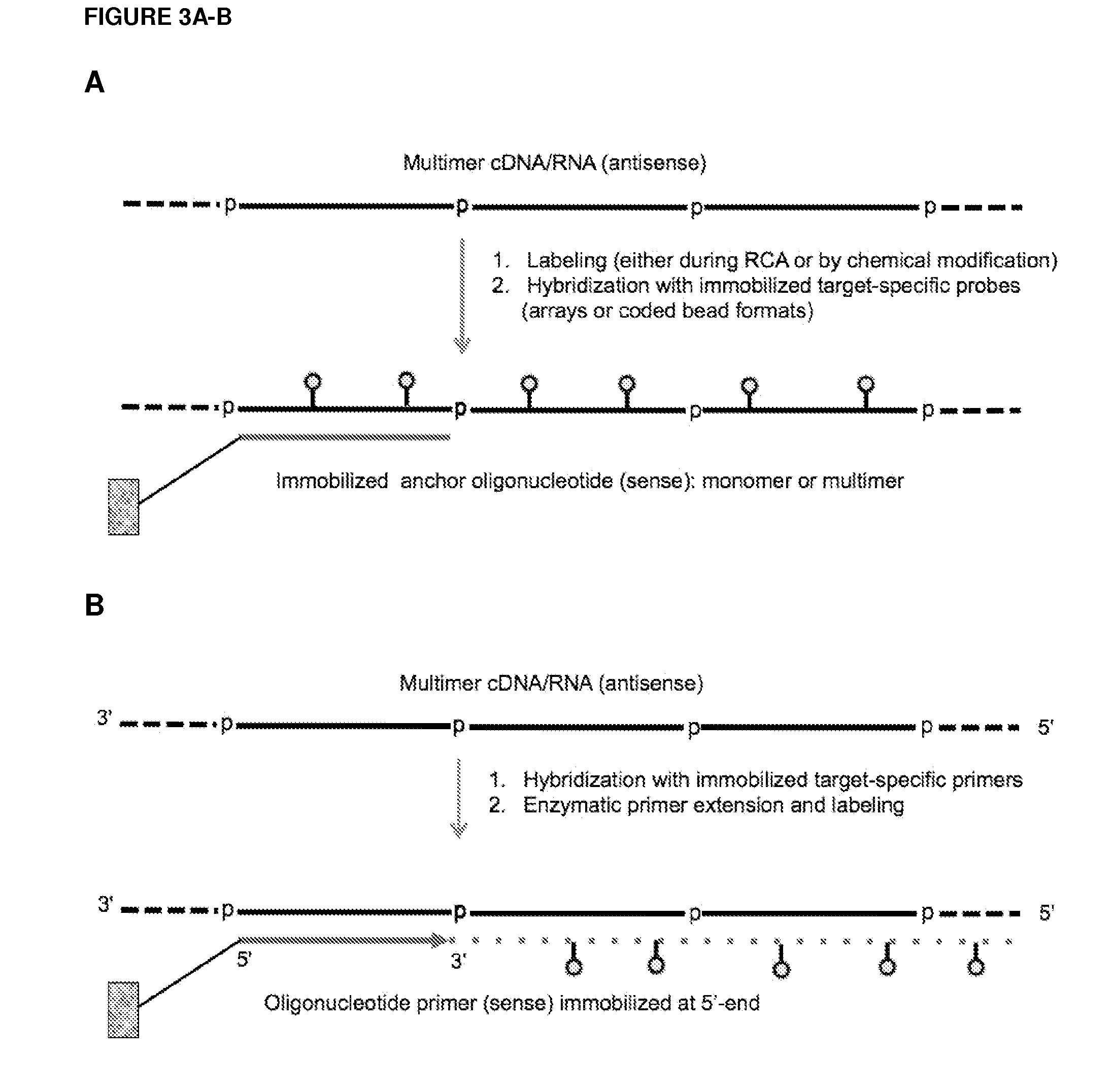Methods and compositions for detection of small rnas
a technology of rnas and compositions, applied in the field of molecular cell biology, can solve the problems of insufficient methods, limited number of labels, and difficult to isolate a pure fraction of mirnas, and achieve the effects of efficient circularization of both 2′-oh, high efficiency and similar efficiency
- Summary
- Abstract
- Description
- Claims
- Application Information
AI Technical Summary
Benefits of technology
Problems solved by technology
Method used
Image
Examples
example 1
[0165]Circularization of 2′-OH miRNAs by T4 RNA ligase and CircLigase. The structure of let-7b and miR-127 are shown in FIG. 27A. The 5′ ends of let-7b and miR-127 RNAs were 32P-phosphorylated by T4 Polynucleotide Kinase (NEB) with [γ32P]ATP (Perkin Elmer) according standard protocols. The reaction products were passed through a G-25 spin column (GE Healthcare) to remove the unincorporated [γ32P]ATP. 5′-32P-labeled linear miRNAs (80 nM) were incubated with or without 0.67 U / μl T4 RNA Ligase 1 (T4RnL1, NEB) for 1 hour at 37° C. in standard ligation buffer (10 mM MgCl2, 10 mM DTT, 1 mM ATP, 50 mM Tris-HCl, pH 7.8); or with or without 5 U / μl CircLigase (Epicentre Biotechnologies) for 1 hour at 60° C. in the supplied buffer (0.05 mM ATP, 5 mM MgCl2, 2.5 mM MnCl2, 1 mM DTT, 10 mM KCl, 50 mM MOPS, pH 7.5). CircLigase is a thermostable enzyme which, according to the manufacturer, can circularize single-stranded DNAs of 30 nt or longer. (The ability of this enzyme to circularize 2′-OH miRNA...
example 2
Adenylation and Circularization of miRNAs Containing Either 2′-OH or 2′-OMe at their 3′-Ends
[0166](A) Using T4 RNA Ligase 1: Two synthetic let-7b miRNAs (Table 1) that share the same sequence except that one contains a 2′-OH and the other a 2′-OMe at their 3′ ends (see FIG. 28D, right panel) were purchased from IDT (Coralville, Iowa). 5′ ends of these RNAs were 32P-phosphorylated by T4 Polynucleotide Kinase (NEB) as described in Example 1. 5′-32P-labeled linear miRNAs (80 nM) were incubated with or without 0.67 U / μl T4 RNA Ligase 1 (NEB) in the presence and absence of 1 mM ATP for 1 hour at 37° C. as described in Example 1. The reaction products were analyzed on a denaturing 15% polyacrylamide gel (FIG. 28A). Lanes 1-3 correspond to the 2′-OH miRNA and lanes 3-6 correspond to the 2′-OMe miRNA. Lanes 1 and 4 have ATP added but no RNA ligase whereas lanes 3 and 6 have RNA ligase added but no ATP. Lanes 2 and 5 had both RNA ligase and ATP. The products were identified as follows: Lane ...
example 3
Circular miR-127 miRNA can Serve as a Template for Multimeric cDNA Synthesis by Rolling Circle Reverse Transcription (RT-RCA) Using Primers of Different Lengths
[0169](A) A synthetic let-7b miRNA containing a 2′-OH at its 3′-end and a 5′-phosphate was circularized by T4 RNA ligase 1 as described in Example 1. The circularized miRNA was used as template for reverse transcription using as RT primers synthetic DNA oligonucleotides (IDT) of three different lengths:
5′-ACCACACAACCTAC-3′(Table 1: 7bRT14, complementary to nt 8-21 of let-7b);5′-CACACAACCTAC-3′(Table 1: 7bRT12, complementary to nt 8-19 oflet-7b);5′-CACAACCTAC-3′(Table 1: 7bRT10, complementary to nt 8-17 oflet-7b).
[0170]The 5′ ends of these primers and an appropriate DNA ladder (Invitrogen) were 32P-phosphorylated by T4 Polynucleotide Kinase (NEB) with [γ32P]ATP (Perkin Elmer) according standard protocols. The reaction products were passed through a G-25 spin column (GE Healthcare) to remove the unincorporated radiolabeled ATP....
PUM
| Property | Measurement | Unit |
|---|---|---|
| pH | aaaaa | aaaaa |
| pH | aaaaa | aaaaa |
| pH | aaaaa | aaaaa |
Abstract
Description
Claims
Application Information
 Login to View More
Login to View More - R&D
- Intellectual Property
- Life Sciences
- Materials
- Tech Scout
- Unparalleled Data Quality
- Higher Quality Content
- 60% Fewer Hallucinations
Browse by: Latest US Patents, China's latest patents, Technical Efficacy Thesaurus, Application Domain, Technology Topic, Popular Technical Reports.
© 2025 PatSnap. All rights reserved.Legal|Privacy policy|Modern Slavery Act Transparency Statement|Sitemap|About US| Contact US: help@patsnap.com



